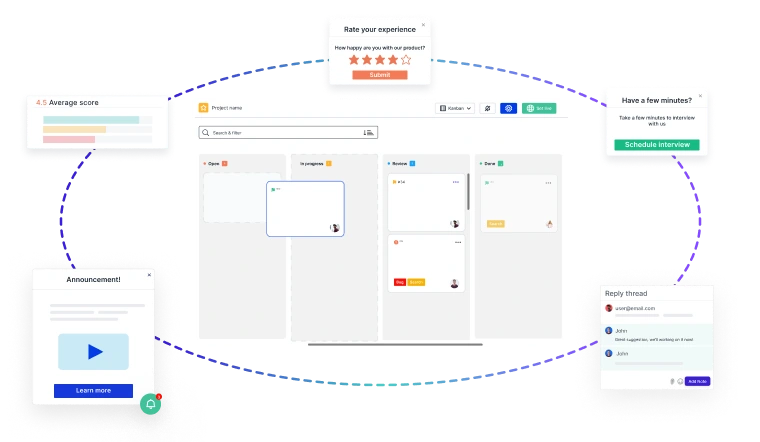If you’re sprinting with delivery while discovery is stuck in the parking lot, you’re not agile. You’re just speeding blind.
Most product teams talk about dual-track agile, but few actually do it well. Discovery gets sidelined. Delivery sprints forward. And by the time you ship, no one’s quite sure who you built it for.
To fix this disconnect, we teamed up with Ant Murphy, product coach and dual-track specialist, to break down exactly how to run discovery and delivery side by side — without turning your roadmap into a chaos board.
This is your playbook for doing dual track right: grounded in systems, supported by templates, and focused on impact.
🚀 What You’ll Learn in This Article:
- How to set up a dual track process without creating silos
- Why it’s so hard to run discovery and delivery in sync — and how to fix it
- What insights from discovery matter while you’re shipping
- How to iterate without breaking the loop
- When to wrap up discovery and call it a win
Plus: Free templates from Ant here in Usersnap!
How to Set Up Dual-Track Agile (Not Just Talk About It)
“Discovery isn’t something you squeeze in between shipping. It’s the other half of building the right thing.” — Ant Murphy
Here’s what dual-track agile really means:
- Discovery and delivery happen in parallel, not in sequence
- The team continuously explores problems and ships solutions
- Insights fuel delivery and delivery feeds back into new insights

Key Setup Steps:
- Build a shared cadence: weekly rituals where both tracks sync
- Define roles: who leads discovery? Who keeps the tracks aligned?
- Use the same goals across both tracks (hint: impact, not outputs)
Templates to try:
- Opportunities Discovery Survey Template
- Beta Sign-up & Discovery Template
- Beta QA Template
Why Dual Track Feels Broken in Practice (and How to Fix It)
Let’s be real: most teams say they do dual track. Few survive it.
What usually goes wrong:
- Discovery becomes a background task
- Delivery sprints with zero input from discovery
- Teams confuse “speed” with “progress”.
How Ant Makes It Work:
- Sync regularly: don’t let one track go silent
- Share discoveries in demos — not just features
- Use artifacts (e.g. surveys, patterns) to make insights visible
Pro tip from Ant: Every delivery sprint should include at least one learning loop from discovery.
What Discovery Insights Actually Matter Mid-Sprint
“Not all insights are equal. Some spark action — others just spark noise.” — Ant Murphy
You don’t need all the discovery insights before you ship.
You need the right ones.
Insights to prioritize:
- Behavioral triggers
- Repeated pain points
- Workarounds that signal opportunity
Template to explore:
Improvement Discovery 2.0: Use micro-surveys or fast user interviews during delivery, not after.
How to Deliver Iteratively Without Losing the Big Picture
“Iterative” doesn’t mean “make it up as you go.”
Ant’s Advice on Iteration:
- Tie each delivery to a clear learning goal
- Keep the feedback loop alive: user input → iteration → result
- Don’t isolate discovery folks from the dev crew
“Shipping fast is great. Shipping with purpose is better.”
Sync delivery stories with discovery insights:
- Jira ticket + user quote
- Feature + feedback reason
- Outcome + learning check
When to Wrap Up and Call Discovery a Success
When is discovery “done”? It’s not a vibe — it’s a decision.
Signs You’re Ready to Wrap:
- You’ve validated the user behavior you’re targeting
- The delivery track has clarity and confidence
- Your insight debt is paid off (not growing)
What Ant Recommends:
Want to run a real loop this week? Here’s how teams use Ant’s toolkit in practice:
- Launch the Beta Sign-Up & Discovery Template before you test
- Run the Opportunities Discovery Survey mid-sprint to catch new insights
- Use the Beta QA Template to gather impressions and fix blockers
🎯 All feedback stays in sync with your delivery board, making learning and building part of the same cycle.
- Use a wrap-up template or a retro to summarize learnings
- Archive artifacts where they’re findable for future cycles
- Celebrate small loops closed — not just big launches
Bonus: Ant Murphy’s Dual Track Toolkit
Watch Interview with Ant & Shannon
Want to put Ant’s advice into action?
These 3 templates help you connect discovery and delivery, without slowing either down:
What’s Next?
Want to apply this on your team?
Start small. Run one delivery sprint with a live discovery check-in.
Then share it.
Accelerate Issue Resolution with Visual Bug Reporting

Identify, capture, and resolve issues faster with screen recordings, screenshots, and contextual feedback—seamlessly integrated into your product development lifecycle.
And if you’re ready to try out a visual bug tracking and feedback solution, Usersnap offers a free trial. Sign up today or book a demo with our feedback specialists.